Learn History Better by Playing
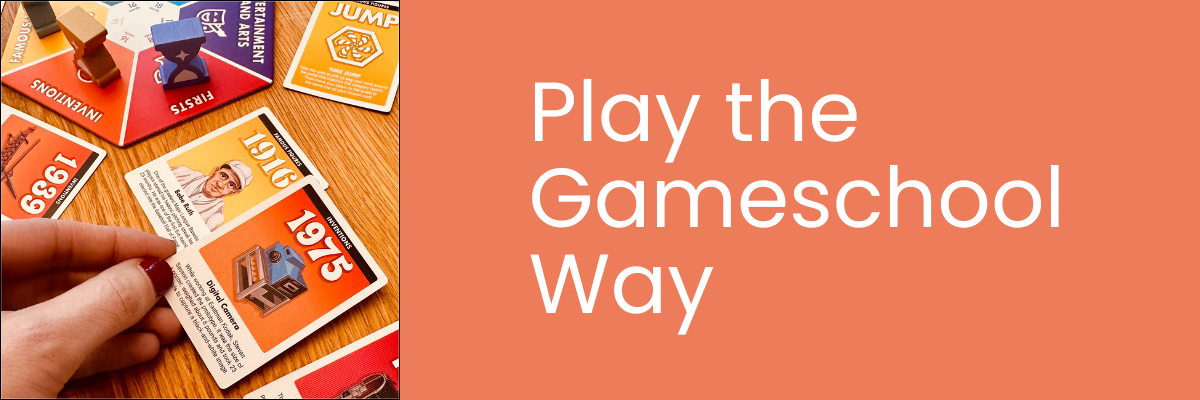
*We may earn commission from qualifying purchases or activity made through affiliate links below.
Never miss a blog.
Please check your email to complete signup.
Have a great day!
Hi Readers! This is Bec, Co-Founder of Homeschool Connective.
History was probably my worst subject in school. It was hard for me to remember dates and details. It could have been due to the curriculum or the teacher, but it made me dislike the subject. A lot.
Now that I’m a homeschool mom, it’s my responsibility to teach my kids History. This was scary at first, but I soon realized what makes learning about the past so special and meaningful.
I want my kids to understand that History doesn’t have to be about memorizing boring dates. It’s about understanding the important people, discoveries, events, and achievements that came before us.
Sharing the stories, good or bad, of those who made an impact in their time, inspiring us to make an impact in ours.
Perhaps I would have liked History in school if it had been taught to me this way. The way I learned provided no opportunity to connect with these stories on a personal level.
When teaching my kids, I often try to find resources that are in line with how they like to learn. My goal is to spark an interest if possible. Sometimes we follow a curriculum, sometimes we read books or watch documentaries, and sometimes we play board games!
We have listed some game ideas below!
13 History Game Ideas
Time Jumpers (highlighted below)
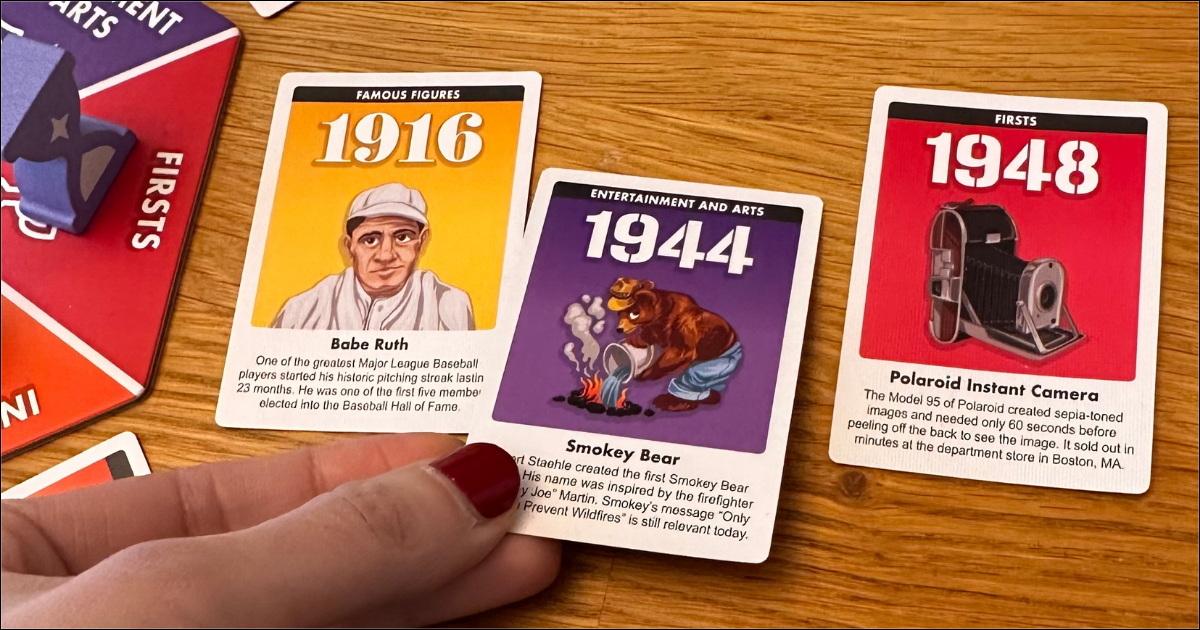
- Ages: 8+
- Players: 2-5
- Skills Practiced: History, Strategy
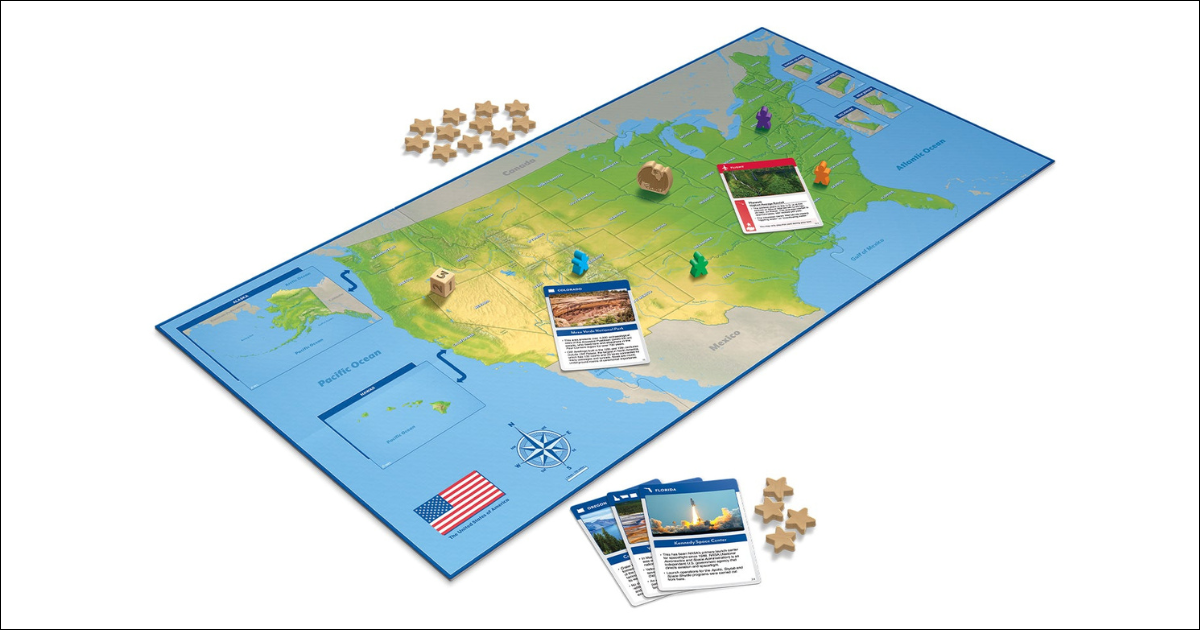
- Ages: 10+
- Players: 2-5
- Skills Practiced: History, Geography
Timeline Twist Card Game
- Ages: 8+
- Players: 2-6
- Skills Practiced: History
Herstory: The Board Game of Remarkable Women
- Ages: 8+
- Players: 2-5
- Skills Practiced: Women in history
Memoir ‘44 - WWII Historical Board Game
- Ages: 8+
- Players: 2-8
- Skills Practiced: History, WWII
Trekking Through History
- Ages: 10+
- Players: 1-4
- Skills Practiced: History
First in Flight
- Ages: 12+
- Players: 1-4
- Skills Practiced: History of Aviation
Chronology
- Ages: 14+
- Players: 2-8
- Skills Practiced: History
Men-Nefer: Journey Through Ancient Egypt
- Ages: 14+
- Players: 1-4
- Skills Practiced: History, Ancient Egypt
The Constitution Quest
- Ages: Teen/Adult
- Players: 2-4
- Skills Practiced: History, The Constitution
Catan Histories: Settlers of America
- Ages: 14+
- Players: 3-4
- Skills Practiced: US History, US Westward Expansion
History Channel Trivia Game
- Ages: 14+
- Players: 2+
- Skills Practiced: History
1775 Rebellion: The American Revolution
- Ages: 14+
- Players: 2-4
- Skills Practiced: US History, American Revolution
Time Jumpers
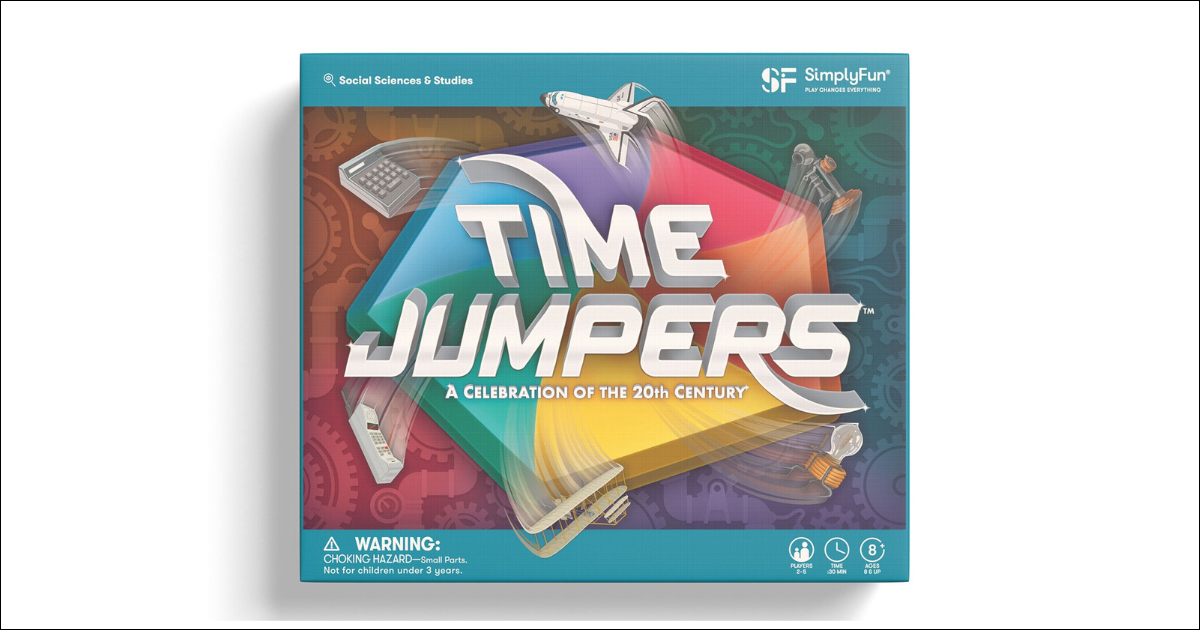
In Time Jumpers, you’ll learn about different events, achievements, and discoveries of the 1900s. Collect cards and arrange them on your board in the correct order to earn points. This game is quick and easy once you understand how to play.
Subject: History
Ages: 8+
Number of Players: 2-5
Skills Practiced: History, Strategy
Game Components:
- Small central gameboard
- Large gameboards for each player
- Colorful cards
- Various cardboard tokens
- Wooden hourglass pawns

Gameplay
Step 1: Take a card
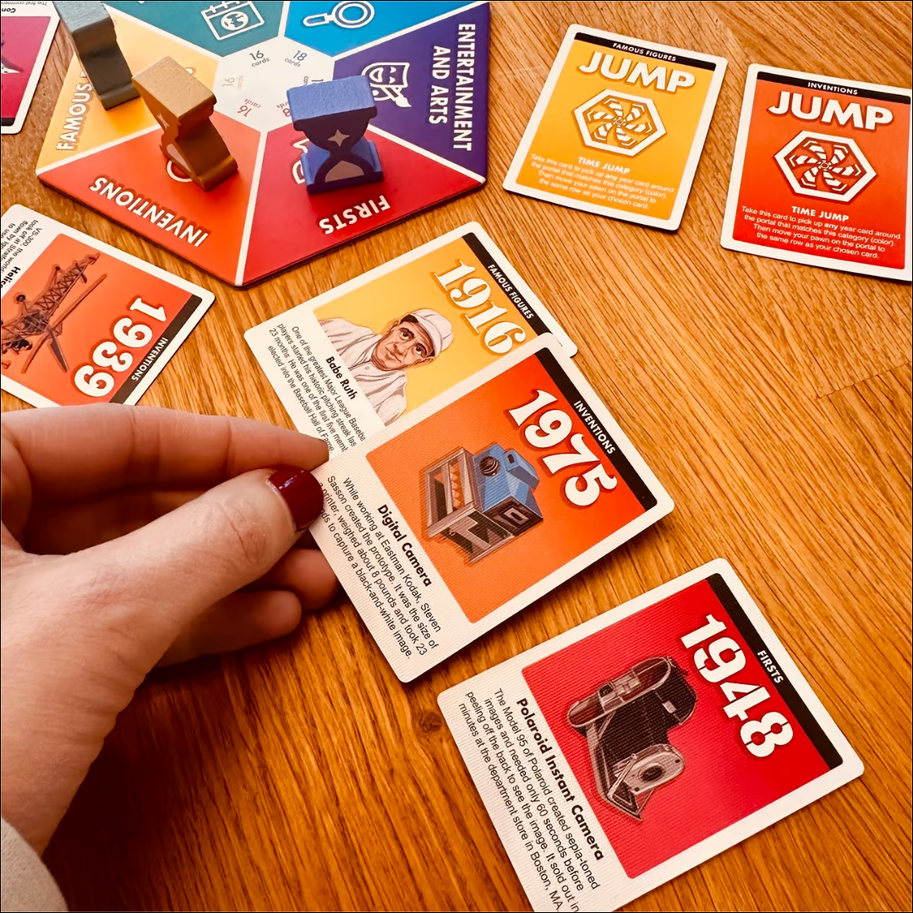
- Take one of the three cards from the row you are in.
Step 2: Place the card on your board

- Place the card anywhere you want on your board.
- You can not move it once it’s placed.
- There are four sections on your board, and you want to complete each section for points.
Step 3: Replace the card
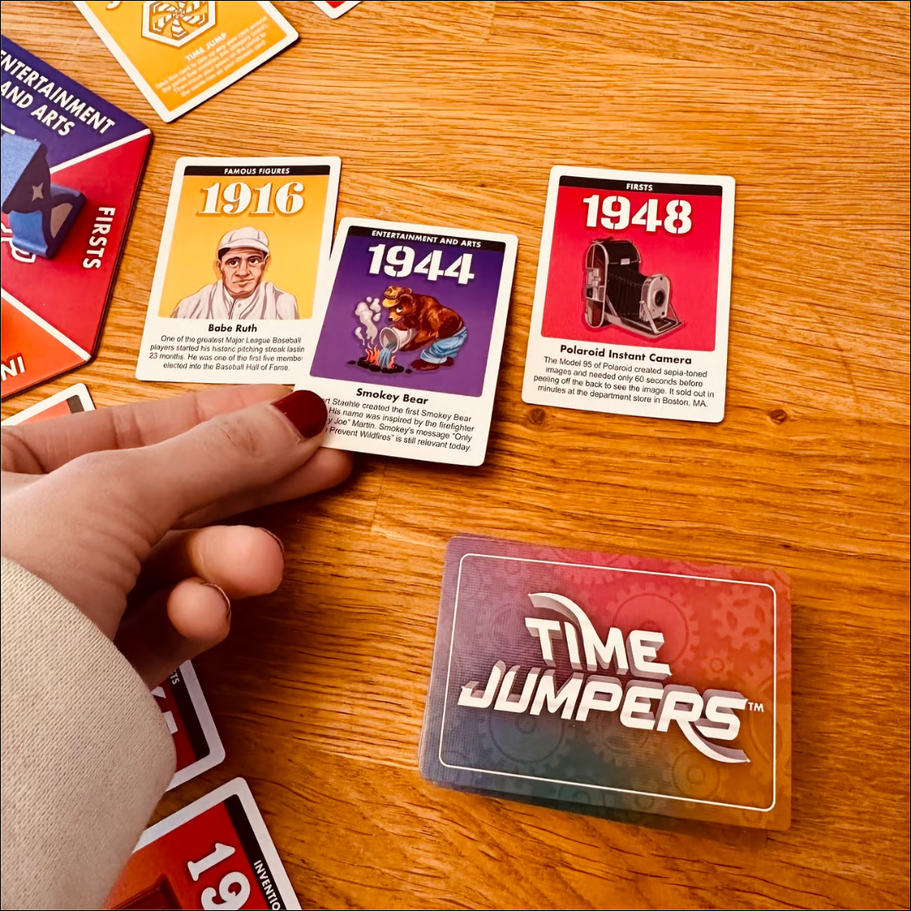
- Place a new card in the empty space from the top of the draw pile.
Step 4: Move your pawn
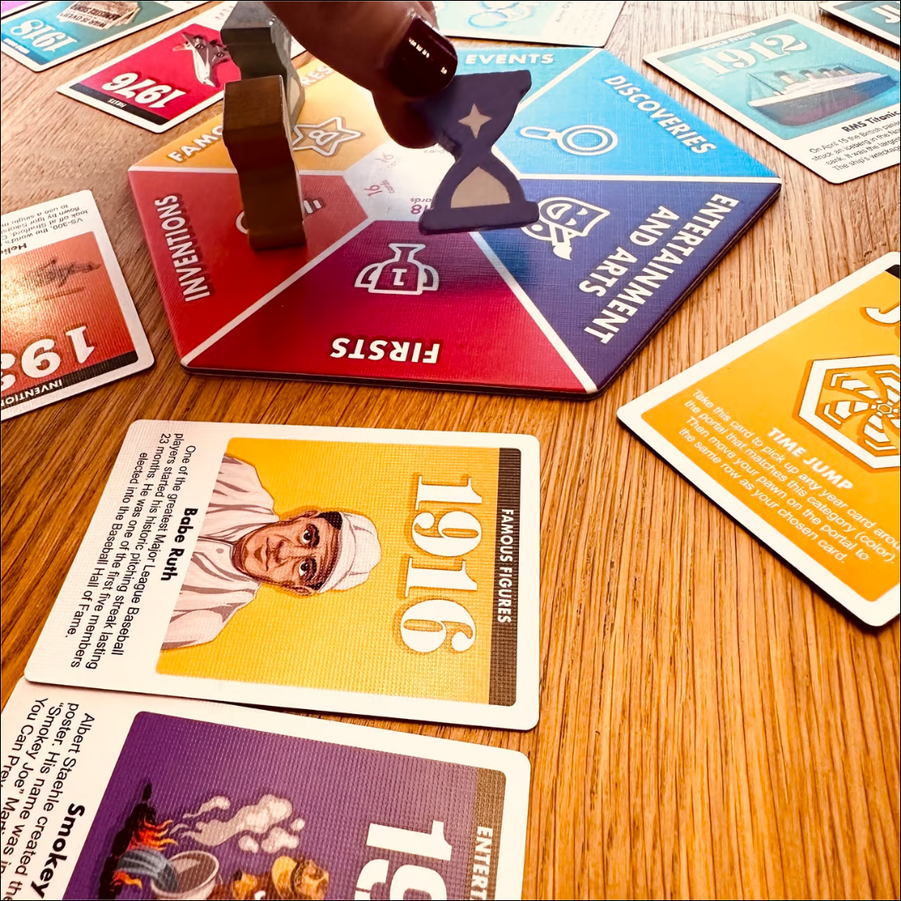
- You can move one space to the left or right.
- Or, you can move to the same color as the card you just picked up.
- JUMP CARDS: If you picked up a Jump card (which allows you to take any card in the play area that matches the Jump card’s color), you will move to the row of the card you take.
Step 5: Complete sections
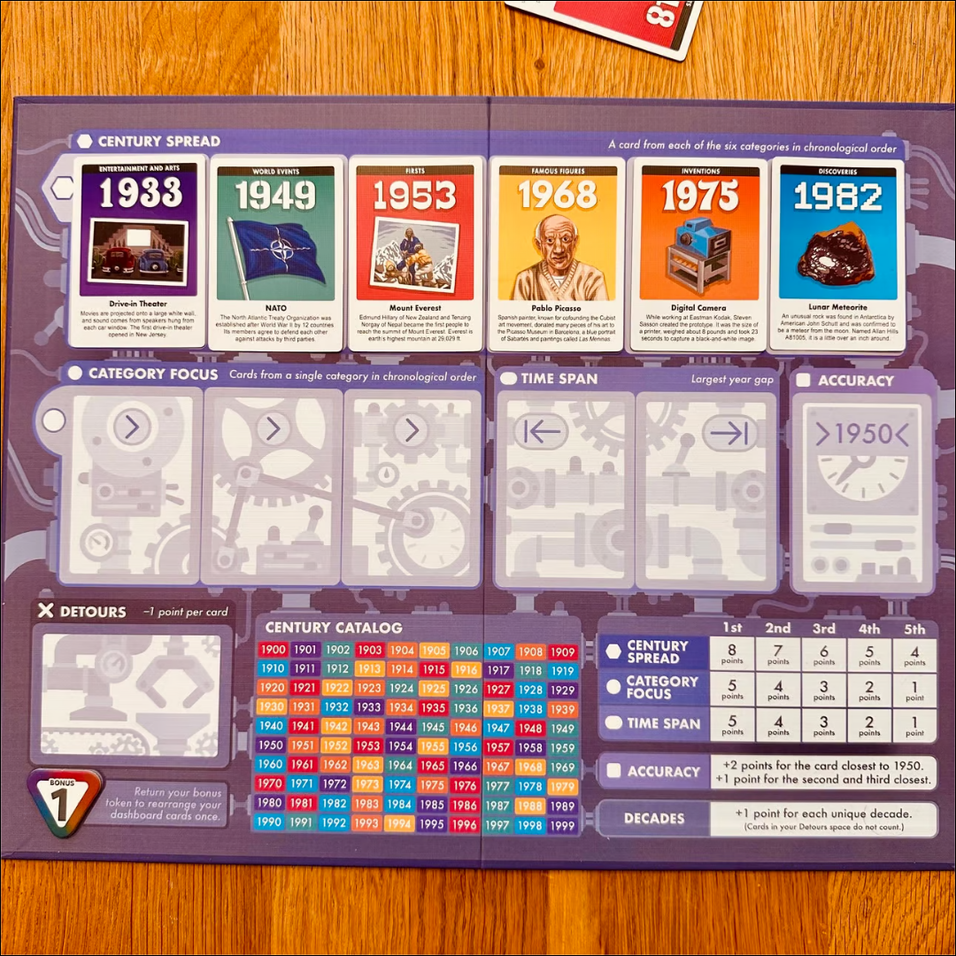
- Complete sections for points.
- The top section (Category Spread) requires one card from each of the six categories (all in chronological order).
- The other sections require:
- Category Focus: Three cards from the same category (in chronological order)
- Time Span: The largest gap you can get between a low year and a high year
- Accuracy: The closest you can get to 1950
Step 6: Take point tokens
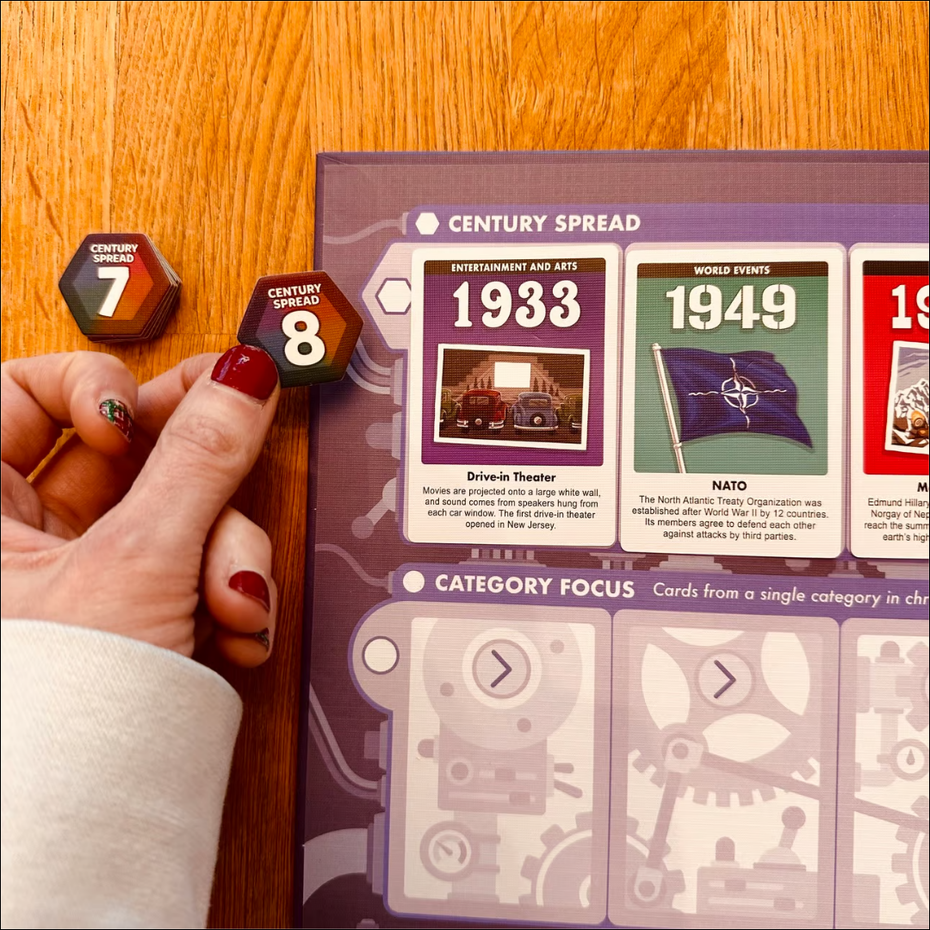
- When you complete the Category Spread or Category Focus sections, take the top scoring token off the pile.
- If you complete the sections first, you get the highest points.
- Points for the other sections are given at the end of the game.
Step 7: Using detours
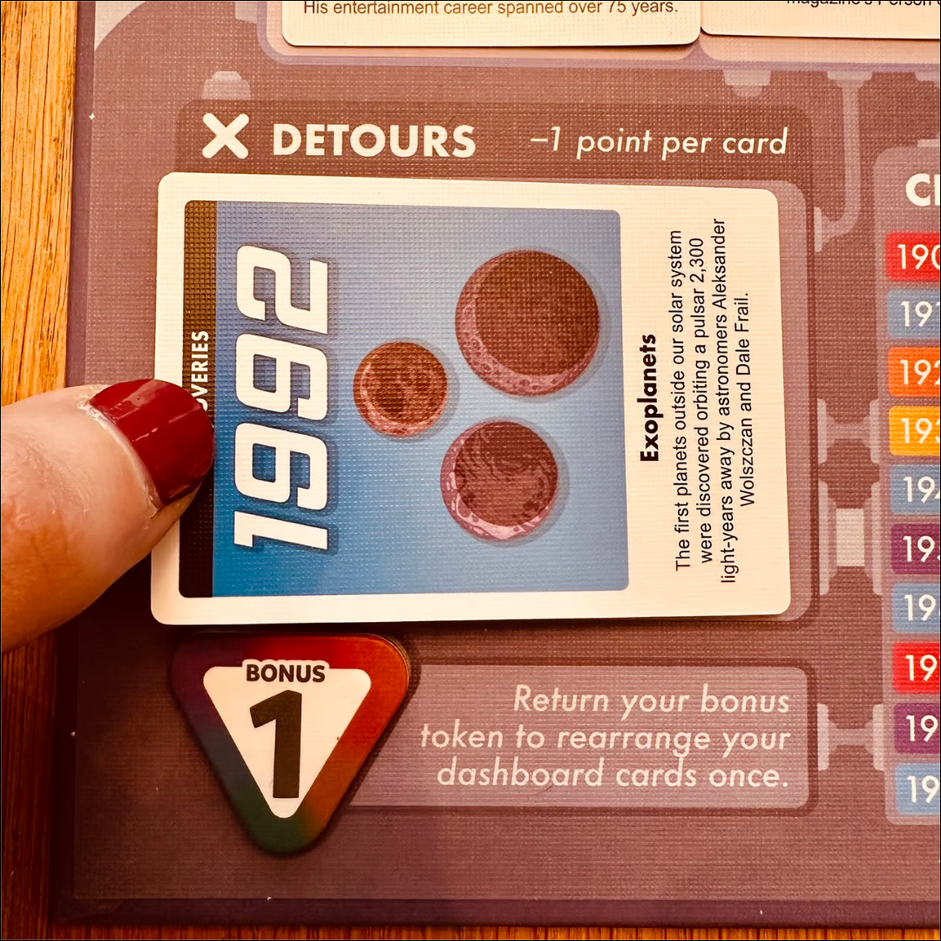
- If you can’t use the card you’ve picked up, you can place it in the detour section of your board. You must subtract one point for each detour card at the end of the game.
- THE BONUS TOKEN: You can see the bonus token here. Each player receives one. You may use it once to reorganize the cards on your board, or you may keep it for a bonus point at the end of the game.
Step 8: Decide when you’re done
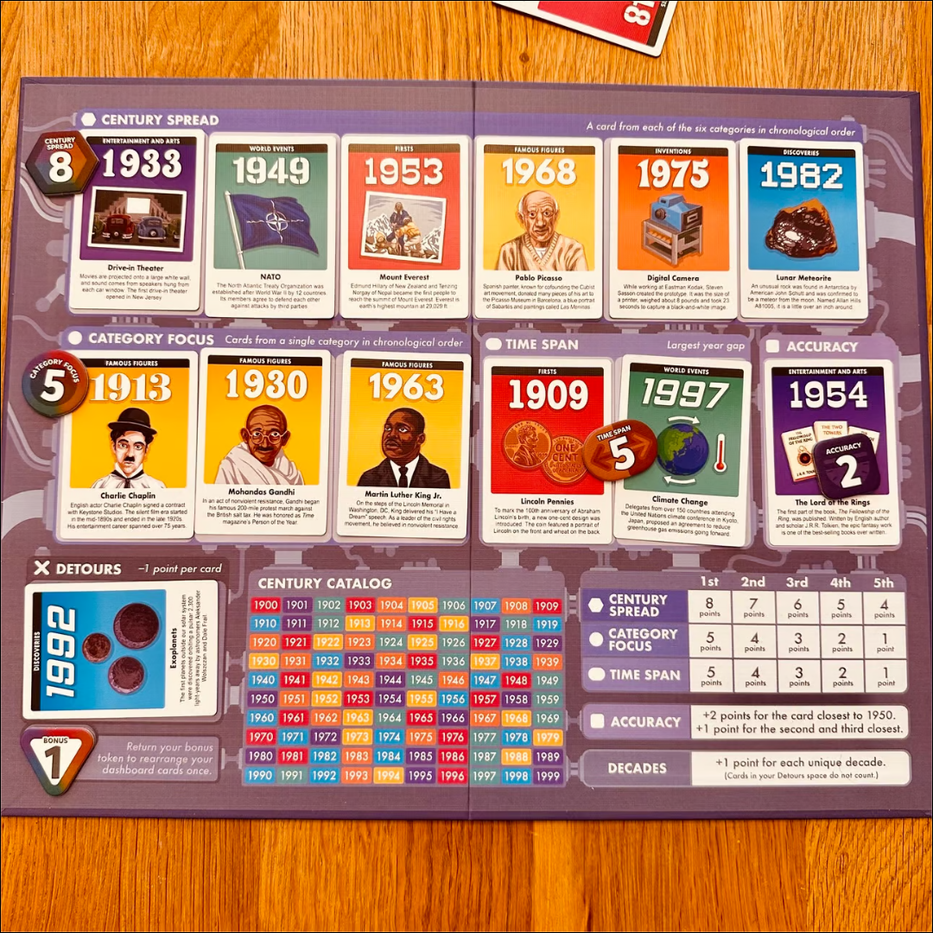
- Each player decides when they’re finished.
- When you have filled in your board the best you can and have determined that the best strategy is to call it quits, declare that you are ending your game.
- Now, wait for the other players to finish. Then add up points.
You can find more modifications for special needs and autism on the game description page.
Why we love this game:
First, the gameplay is simple once you learn what to do. Each turn goes quick. You simply pick up a card, place it on your board, replace the card with a new one, and move your pawn.
The facts on the cards are small chunks of info, which encourages you to read it because you know it won’t be long and complicated.
We love how you just can’t mess up scoring. Not only is everything clearly labeled, the scoring tokens are all different shapes and match the shapes on the board for each section they go with. There is also a scoring chart right on the board that clearly displays how to score everything.
We love the color-coded chart on the board that shows what color each year is. This is helpful when planning ahead and strategizing.
We love the game components, such as the wooden hourglass pawns, the thick, sturdy cardboard gameboards/tokens, and the colorful cards with great illustrations.
And best of all, we love that we are actually learning about history! It’s so fun to read quick facts about what happened in the 1900s. As parents, we can say, “Hey, I remember that!”
The more kids play the game, the more they will naturally become familiar with the dates and facts on the cards.
See Time Jumpers in Action
Looking for a different type of history game? Try Timeline Twist Card Game or Men-Nefer: Journey Through Ancient Egypt.
Where to Find It
You can find Time Jumpers here!
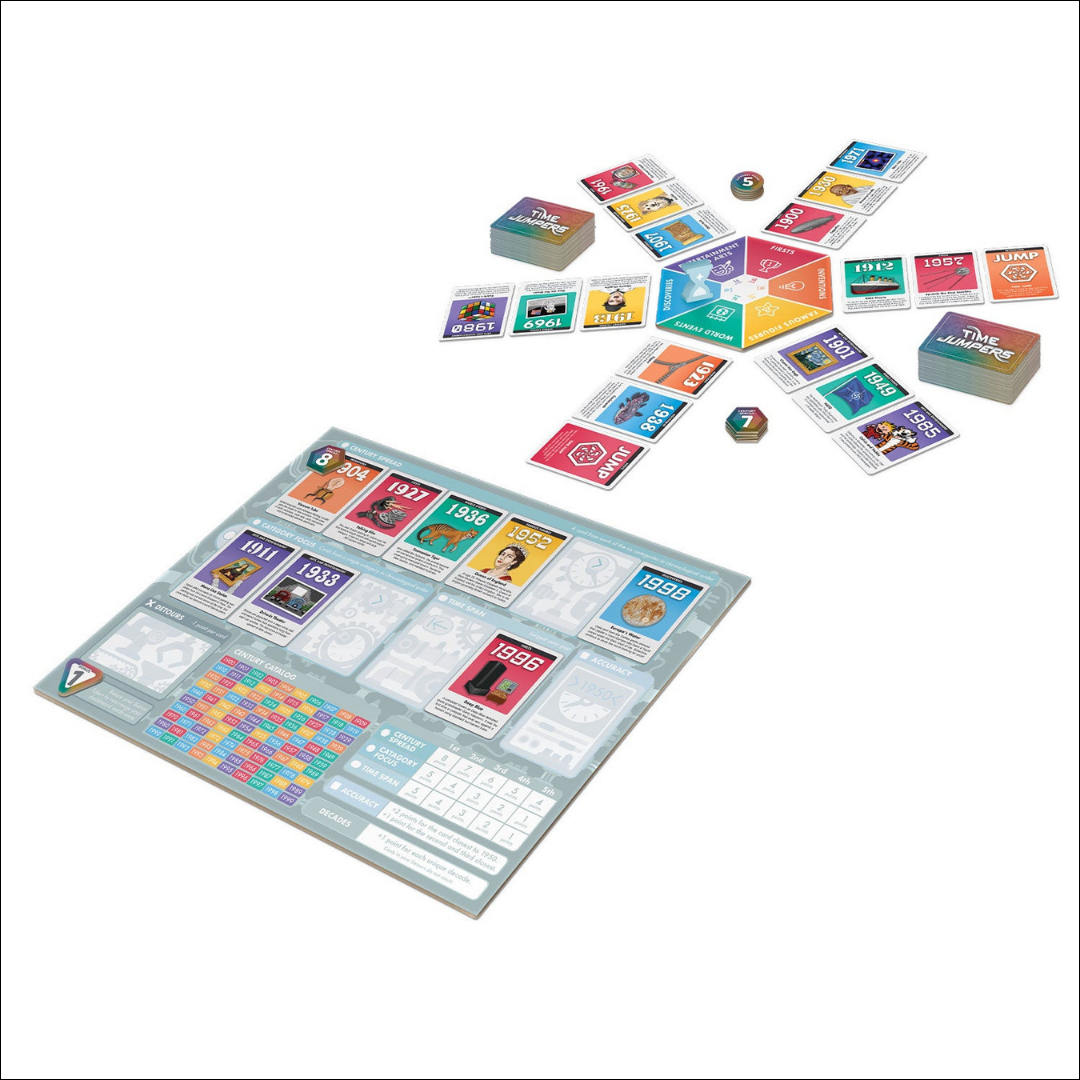
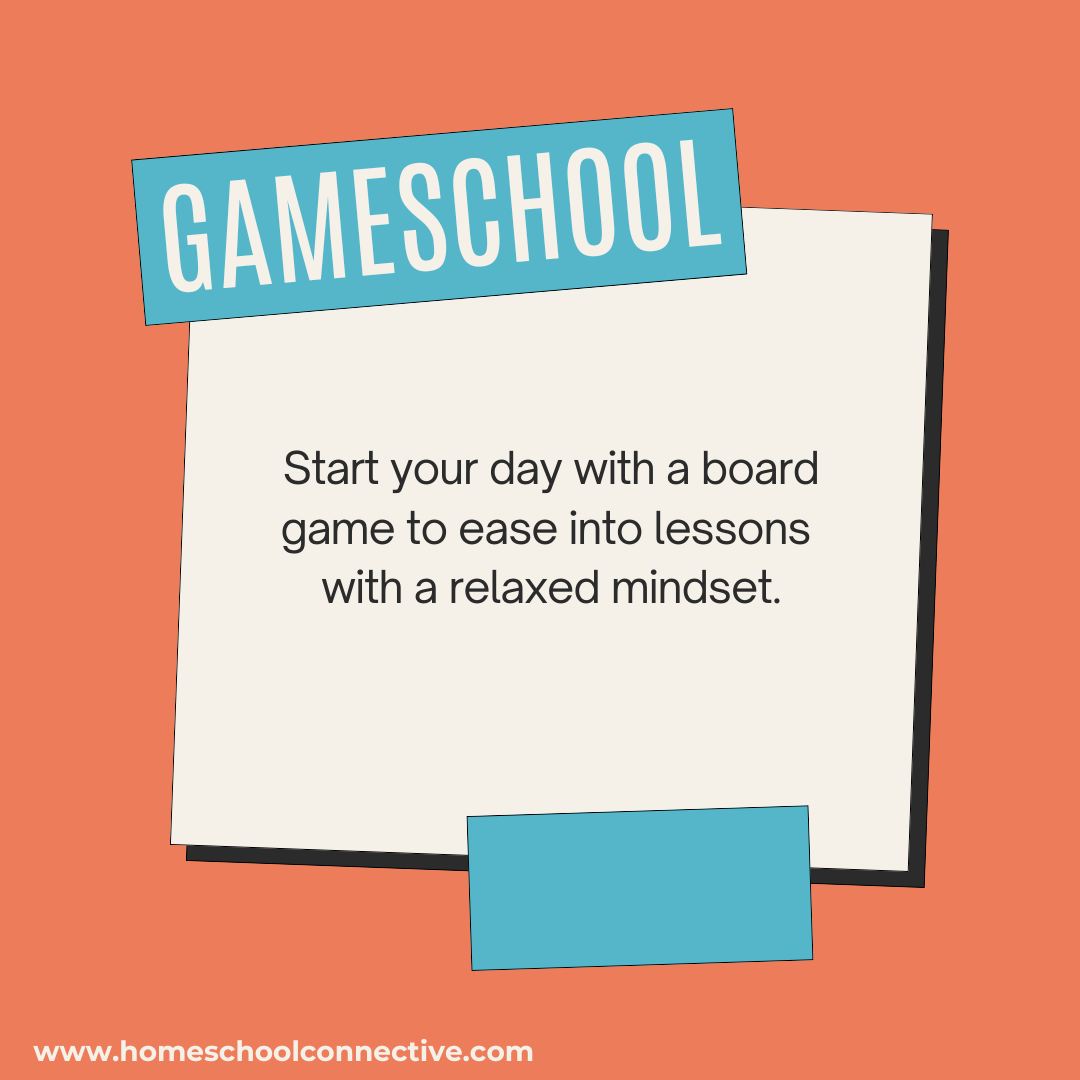
Gameschooling Tips for History
History games make the past come alive in a hands-on, immersive way. They often progress through specific phases or eras, which makes them a great tool to pull out during different stages of history lessons.
Our Advice:
- History games can teach more than just history. They often integrate geography, strategy, and critical thinking. For example, when playing the game, point out geographical locations on a map.
- Homeschooling offers flexibility, so adapt games to fit your educational goals. For history games, you may decide to skip over some of the content that your child isn’t ready for.
- If the game provides facts, read them, even if you just read the title or a small part of the fact
- After gameplay, ask your child something new they learned
- Sometimes history games can be pretty involved, depending on the gameplay and/or content. Be prepared to give your child a break after playing if they need one.
- Since some history games can be quite lengthy, wait until you’ll have enough time to play without feeling rushed
Fun Extras
